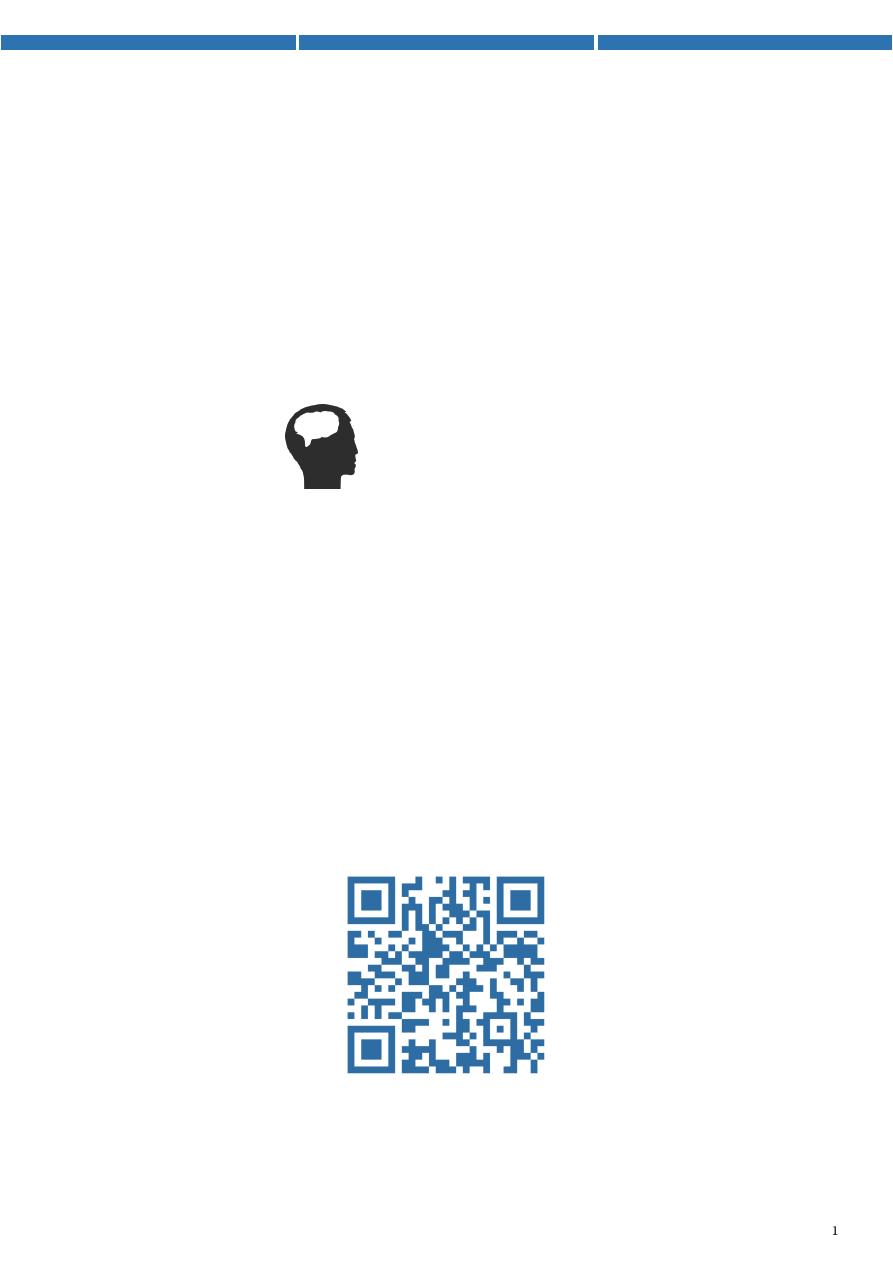
Psychiatry
For
5
th
stage
http://goo.gl/rjRf4F
I
LOKA
©
http://www.muhadharaty.com/psychiatry
I

Content
Topics:
Page:
Psychiatry History
3
Mental state examination
8
Physical examination
16
From doctor
Notes
19
23
See this book www.muhadharaty.com/book/258
Psychiatric assessment has four elements:
History
Mental state examination (MSE)
Selective physical examination
Collateral information

Part1
: Psychiatry History
General information:
Name
for communication, assess memory stat of patient (dementia, substance
abuse)
Age
there is specific diseases occur in specific
age group like dementia not occur in young.
Sex
there is diseases common in male, others
more in female.
Address
level of social address, distance from
local health centers so may need medication for
longer period, social support.
Marital status
if single why till now, if married
is relation good, if divorced how many times?
Occupation
if worker where, stasfied or not? if
not why? if changing job why
?
Date of history taking.
Source of referral:
police, ambulance, family, alone.
History of present illness and duration:
For each individual complaint record its nature (in the patient’s own words as far as
possible); chronology; severity; associated symptoms and associated life events occurring at
or about the same time. Note precipitating, aggravating, and relieving factors. Have these
or similar symptoms occurred before? To what does the patient attribute their symptoms?
Past psychiatric history:
Previous psychiatric diagnoses.
Chronological list of episodes of psychiatric inpatient, day hospital, and outpatient care.
Date, duration, symptoms, and treatment of each.
Alcohol, drug abuse, tobacco include quantity, frequency.
Medical & surgical history:
Current medical conditions.
Chronological list of episodes of medical or surgical illness.
Full psychiatry history:
1
Referral source
2
Reason for referral
3
History of presenting
complaint(s)
4
Systematic enquiry into
other relevant symptoms
5
Past medical/psychiatric history
6
Prescribed and non-prescribed
medication
7
Substance use: illegal drugs,
alcohol, tobacco, caffeine
8
Family history (including
psychiatric disorders)
9
Personal history

Episodes of symptoms for which no treatment was sought.
Any illnesses treated by general physician.
Include illness, operation, accidents, time and treatment.
Any complication after it.
Drug history:
List names and doses of current medication (have they been taking it?)
Previous psychiatric drug treatments.
History of adverse reactions or drug allergy.
Any non-prescribed or alternative medications taken.
Family history:
Father & mother (name, age, occupation, health, education, personality, attitude, if
dead cause of dead, if divorce when and why.
If they have any medical illness or +ve psychological problem.
Any one suicide or think of it? Drinker?
Who is nearer one to patient?
Brothers and sisters and how is the relationship with them?
Sibling and relation with patient.
Home atmosphere.
Illnesses of first and second degree relatives.
Are there any familial illnesses?
Personal history:
Since birth date, place of birth, mother
condition during pregnancy, delivery
(normal, prolonged, instrumental or
operation).
History of prematurity, low birth weight,
convulsion.
Early childhood (breast feeding or bottle).
Developmental (milestone, teething,
talking, walking, bowel and bladder control).
Neurotic symptoms, bed wetting, temper, nail-biting, thumb sucking, night terror,
sleep walking, sleep talking, stammering fear, mannerism, tics.
Behavior (playing alone, hostility, hyperactivity, relation with others especially family).
Adolescence and adulthood (isolation, or peer group) difficulties and reaction to
maturity.

1- Childhood history:
Were there problems during their pregnancy or delivery?
Did they reach development milestones normally?
Was their childhood happy?
In what sort of family were they raised?
2- Educational history:
School, age at start and finish.
Name of school, reaction to school, regularity.
School phobia, difficulties, attitude to teachers and peers.
Achievement and ambition.
University and high education.
Type of further education and qualifications attained.
Questions:
- Which primary and secondary schools did they attend? If more than one of each,
why was this?
- Did they attend mainstream or specialist schools?
- Did they enjoy school - if not, why?
- At what age did they leave school and with what qualifications?
- If they left higher education before completing the course—why was this?
3- Occupational history:
Age of starting work, chronological lists of job, and duration changes and cause.
Regularity job, satisfaction economic status and ambition.
Relation to work surrounding.
Account for periods of unemployment in the patient’s history.
Questions:
- Which job did they hold for the longest period?
- Which job did they enjoy most?
- If the patient has had a series of jobs—why did they leave each?
- Is the type of job undertaken consistent with the patient’s level of educational
attainment?
Relationships:
Sexual orientation.
Chronological account of major relationships.
Reasons for relationship breakdown.

Are they currently in a relationship?
Do they have any children from the current or previous relationships?
Who do the children live with?
What relationship does the patient have with them?
Menstrual history:
Age at menarche.
Cycle regularity and duration.
Last period.
Dysmennohea, premenstrual symptoms & tension.
Sexual history:
Masturbation (worries and guilt) and fantasia.
Any deviation or dysfunction.
Orientation, homosexual or heterosexual.
Experience, age, type.
Marital history:
Marital age, date, number of partners, name, age, occupation, personality, health.
Mode of intercourse, impotence.
Satisfaction and relation.
Abortion and contraception.
Extra-marital relationship.
Children, list of chronological order, their names age sex education occupation health
personality and relation with each.
Forensic history:
Illegal acts, counts & prison
Have they been charged or convicted of any offences?
What sentence did they receive?
Do they have outstanding charges or convictions at the moment?
Social history:
Interest, hobbies and financial stat.
Current occupation.
Are they working at the moment? If not, how long have they been off work and why?
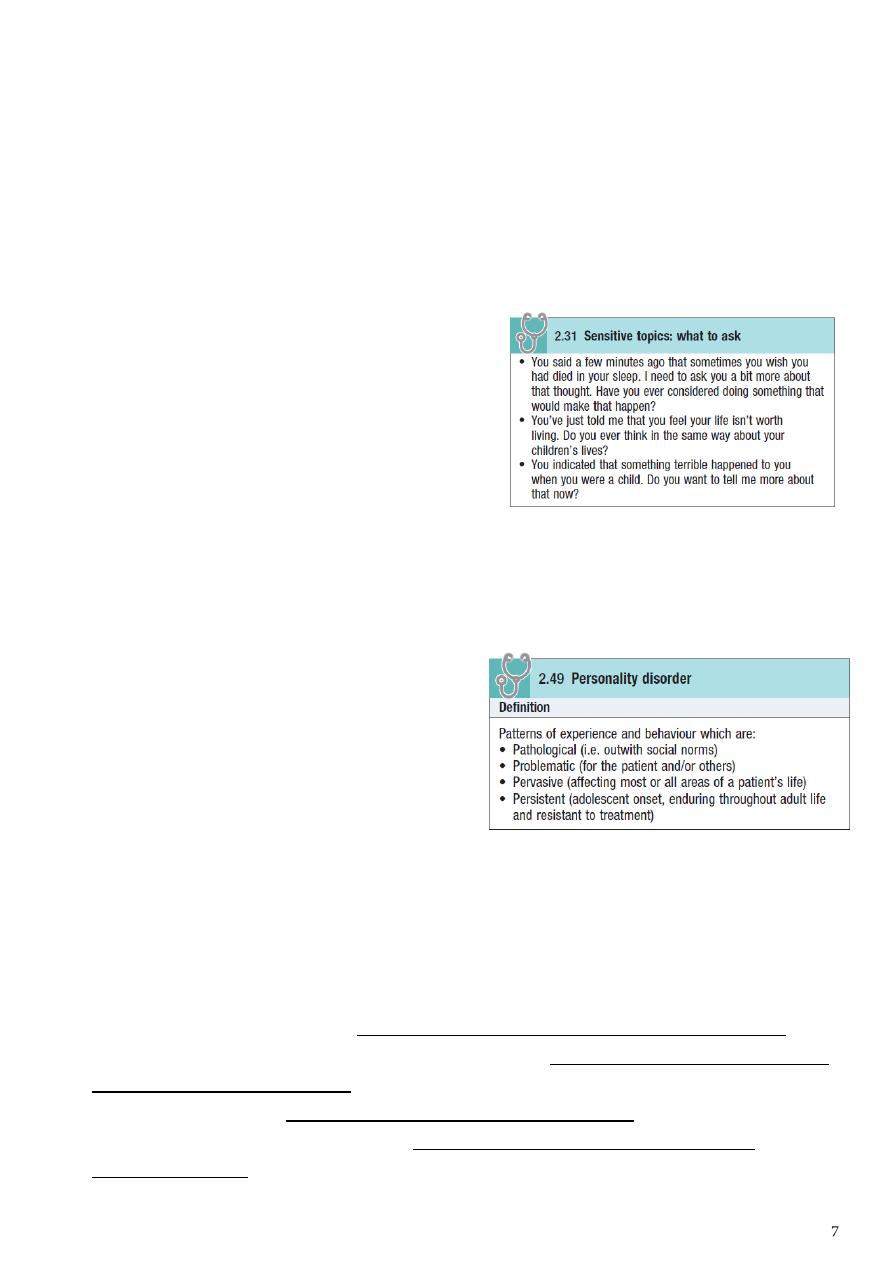
Current family/relationship situation.
Alcohol and illicit drug use.
Main recreational activities.
Premorbid personality:
How would they describe themselves before they became ill?
How would others have described them?
Sensitive topics:
Sexual issues sexual dysfunction, gender
identity.
Major traumatic experiences rape,
childhood, sexual abuse, witnessing a death.
Illicit drug use.
Crime.
Suicidal or homicidal ideas.
Non-clinical settings police stations, prisons.
Collateral history
This is important, especially when the patient:
Has a severe learning disability or
confusional state
Has a mental disorder that prevents
effective communication
Is very disturbed or uncooperative.
More information:
Depression history taking (( www.geekymedics.com/depression-history-taking ))
Communication tips with patient with dementia (( www.geekymedics.com/patient-
dementia-communication-tips ))
Bipolar disorders (( www.geekymedics.com/bipolar-disorder ))
Assessment of confused patient (( www.geekymedics.com/delirium-acute-
confusional-states ))

Part2
: Mental state examination (MSE)
The mental state examination is a structured way of observing and describing a patient’s
current state of mind, under the domains of appearance, attitude, behavior, mood and
affect, speech, thought process, thought content, perception, cognition and insight.
The purpose of the MSE is to obtain a comprehensive cross-sectional description of the
patient’s mental state, which, when combined with the biographical and historical
information of the psychiatric history, allows the clinician to make an accurate diagnosis
and formulation, which are required for coherent treatment planning.
MSE involves:
Observation of the patient
Incorporation of relevant elements of the history
Specific questions exploring various mental phenomena
Short tests of cognitive function.
Elements of the Mental State Examination (MSE):
Appearance
Behavior
Speech
Mood
Thought form
Thought content
Perceptions
Cognition
Insight
Risk assessment
1- Appearance:
Age, Sex, Ethnic origin
Dress – appropriate?
Signs of self-harm?
General elements attire, signs of self-neglect
Facial expression
Scars, tattoos, features of injury.

Signs of physical disease spider naevi (chronic alcoholic liver disease), exophthalmos
(thyrotoxicosis).
2- Behavior:
Observe:
o Cooperation, eye contact
o Rapport co-operative, talkative, friendly.
o Social behavior aggression, disinhibition
o Overactivity agitation, compulsions
o Underactivity stupor, motor retardation
o Abnormal activity posturing, involuntary movements.
Definitions:
o Agitation A combination of psychic anxiety and excessive, purposeless motor
activity.
o Compulsion An unnecessary, purposeless action that the patient is unable to
resist performing repeatedly.
o Disinhibition Loss of control over normal social behavior.
o Motor retardation Decreased motor activity, usually a combination of fewer and
slower movements.
o Posturing The maintenance of bizarre gait or limb positions for no valid reason.
3- Speech:
Observe:
o Articulation stammering, dysarthria.
o Quantity mutism, garrulousness.
o Rate pressured, slowed.
o Volume whispering, shouting.
o Tone and quality accent, emotionality.
o Fluency staccato, monotonous.
o Abnormal language neologisms, dysphasia, clanging.
o Pressured, Articulation, spontaneity.
Definitions:
o Clang associations Thoughts connected by having a similar sound rather than by
meaning.
o Mutism Absence of speech without impaired consciousness.
o Neologism An invented word, or a new meaning for an established word.
o Pressure of speech Rapid, excessive, continuous speech (due to pressure of
thought).

o Word salad Meaningless string of words, often with loss of grammatical
construction.
o Echolalia Senseless repetition of the interviewer’s words.
4- Mood:
Disturbance of mood is the most important feature of depression, mania and anxiety,
but mood changes commonly occur in other mental disorders such as schizophrenia
and dementia.
Abnormalities of mood consist of:
o Problematic pervasive mood depressed, elated, anxious, fearful, angry,
suspicious, irritable, perplexed.
o Abnormal range flattened, expanded.
o Abnormal reactivity blunted, labile, catastrophic.
o Inappropriateness incongruous to circumstances.
Ask the patient:
o How has your mood been lately?
o Have you noticed any change in your emotions recently?
o Has your family commented recently on your mood?
o Do you still enjoy things that normally give you pleasure?
Findings:
o Mood – low / euthymic / elated / anxious / angry / apathetic / agitated.
o Affect – blunted / flat / labile / congruent with current topic or mood.
Definitions:
o Blunting Loss of normal emotional sensitivity to experiences.
o Catastrophic reaction An extreme emotional and behavioural overreaction to a
trivial stimulus.
o Flattening Loss of the range of normal emotional responses.
o Incongruity A mismatch between the emotional expression and the associated
thought.
o Lability Superficial, rapidly changing and poorly controlled emotions.
5- Thought form:
Elements of thought form are:
o Rate or speed pressure of thought, retardation (slowing)
o Flow flights of ideas, circumstantiality, perseveration, is thought in a logical
order, with one thing leading to the next?
o Sequencing loosening of associations
o Abstract thinking concrete thought.

Definitions:
o Circumstantiality Trivia and digressions impairing the flow but not direction of
thought.
o Concrete thinking Inability to think abstractly.
o Flight of ideas Rapid shifts from one idea to another, retaining sequencing.
o Loosening of associations Logical sequence of ideas impaired, Subtypes include
knight’s move thinking, derailment, thought blocking and, in its extreme form,
word salad.
o Perseveration Inability to shift from one idea to the next.
o Pressure of thought Increased rate and quantity of thoughts.
7- Thought content:
Ask the patient about:
o What have your main worries been recently?
o What has been on your mind lately?
o Do you have any particular thoughts you keep coming back to?
Divided into:
o Preoccupations are common in normal and abnormal mood states: an anxious
person worries about physical illness, or the morbid thoughts of depression.
o Ruminations are preoccupations which are abnormal because they are so
repetitive or groundless. They occur in hypochondriasis and obsessional disorders.
o Abnormal beliefs fall into two categories:
Those that are not diagnostic of mental illness, e.g. overvalued ideas,
superstitions, magical thinking.
Those that invariably signify mental illness, i.e. delusions.
The main difference is that delusions either lack a cultural basis for
understanding the belief or have been derived from abnormal processes.
Definitions:
o Hypochondriasis Unjustified belief of suffering from a particular disease in spite
of appropriate examination and reassurance.
o Morbid thinking Depressive ideas, e.g. themes of guilt, burden, unworthiness,
failure, blame, death, suicide.
o Phobia A senseless avoidance of a situation, object or activity stemming from a
belief that has caused an irrational fear.
o Preoccupation Beliefs that are not inherently abnormal but which have come to
dominate the patient’s thinking.
o Ruminations Repetitive, intrusive, senseless thoughts or preoccupations.
o Obsessions Ruminations which persists despite resistance.
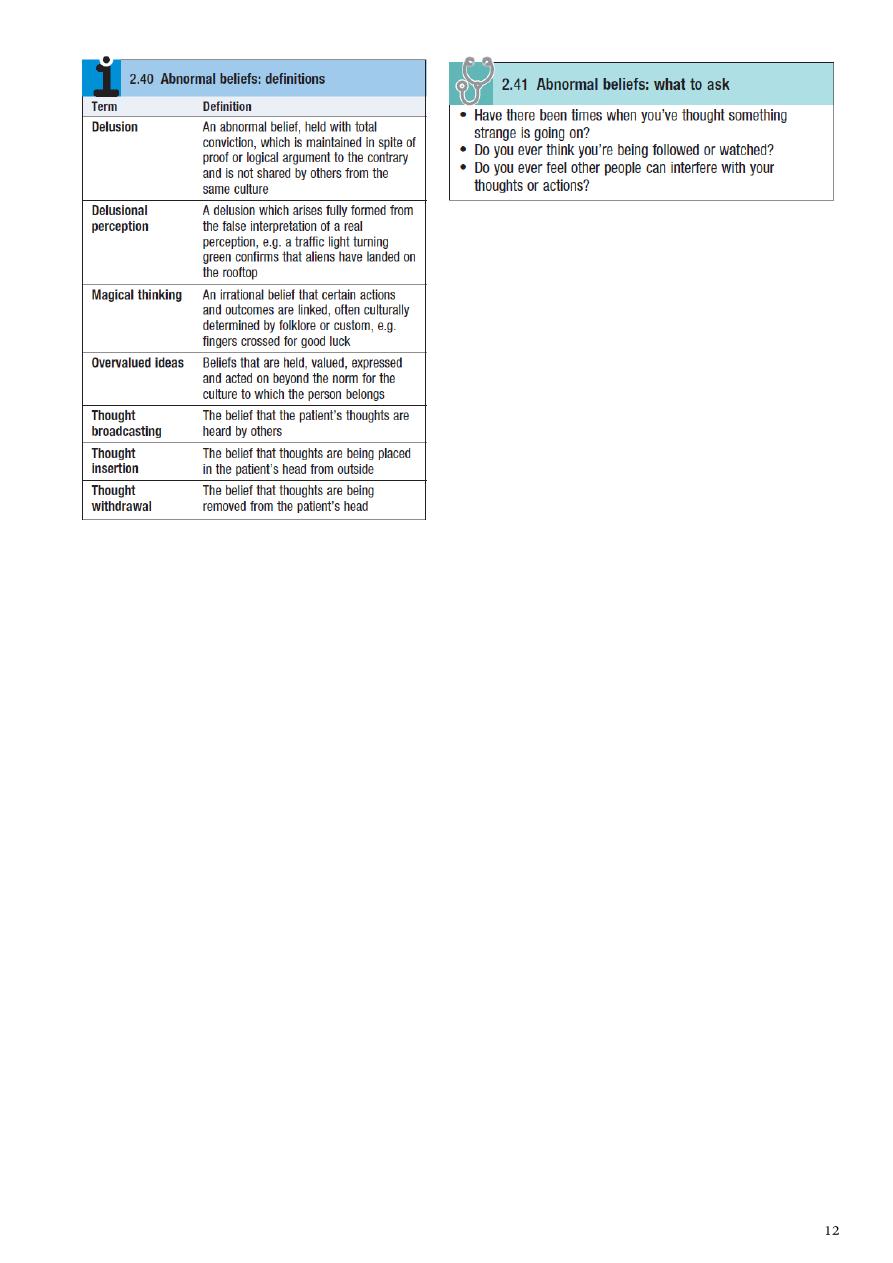
7- Perception:
Ask the patient about:
o Do you ever hear voices when nobody is talking?
o What do they say?
o Where do they come from?
o Have you had any visions?
Categories:
o Depersonalisation, Derealisation are associated with severe tiredness and
intense anxiety, but also occur in most types of mental illness.
o Altered perceptions: sensory distortions, illusions.
o False perceptions: hallucinations, pseudohallucinations.
o Have you ever felt that you were not real or that the world around you wasn’t real?
Definitions:
o Depersonalisation A subjective experience of feeling unreal.
o Derealisation A subjective experience that the surrounding environment is
unreal.
o Hallucination A false perception arising without a valid stimulus from the
external world.
Types: Auditory (associated with schizophrenia), Visual (with delirium),
Olfactory, Somatic, visceral, Sexual, Gustatory.
Usually indicate severe mental illness, but can occur naturally when going to
sleep (hypnagogic) or waking up (hypnopompic).

o Illusion A false perception that is an understandable misinterpretation of a real
stimulus in the external world.
o Pseudohallucination A false perception which is perceived as part of one’s
internal experience.
8- Cognition:
Core cognitive functions include:
o Level of consciousness
o Orientation to time, place, person.
o Memory instant, short term, intermediate, remote memory.
o Attention and concentration
o Intelligence.
o General knowledge (cultural factors had to be considered always) - Mathematical
problem (for the illiterates, had to be within the patients field of experience)
o Judgment: problem solving ability
o Insight: preserved, loss, partially preserved OR In suspected patients of acute or
chronic brain disorders mini mental state examination (scored test) is preferred to
be applied.
Disorientation is the hallmark of the ‘organic mental state’ found in delirium and
dementia.
Mental disorders are rarely associated with a reduced level of (or clouded)
consciousness, except delirium (which is both a physical and a mental disorder), where
it is common.
Memory function is divided into:
o Registration: test by asking the patient to repeat the names of three unrelated
objects, several random single digits, A person with normal function can repeat at
least five digits.
o Short-term memory: test by giving the patient some new information; once this has
registered, check retention after 5 minutes. Do the same with the names of three
objects; any error is significant. Alternatively, use a six-item name and address.
More than one error indicates impairment.
o Long-term memory is assessed mainly from the personal history that the patient
provides. Gaps and mistakes are often obvious, but some patients confabulate (fill
in gaps in their memory with unconsciously fabricated facts) so check the account
with a family member if possible.
Impaired attention and concentration tested by using simple, repetitive sequences,
such as asking the patient to repeat the months of the year in reverse or to do the
‘serial 7s’ test, in which 7 is subtracted from 100, then from 93, then 86, etc. Note the
finishing point, the number of errors and the time taken.
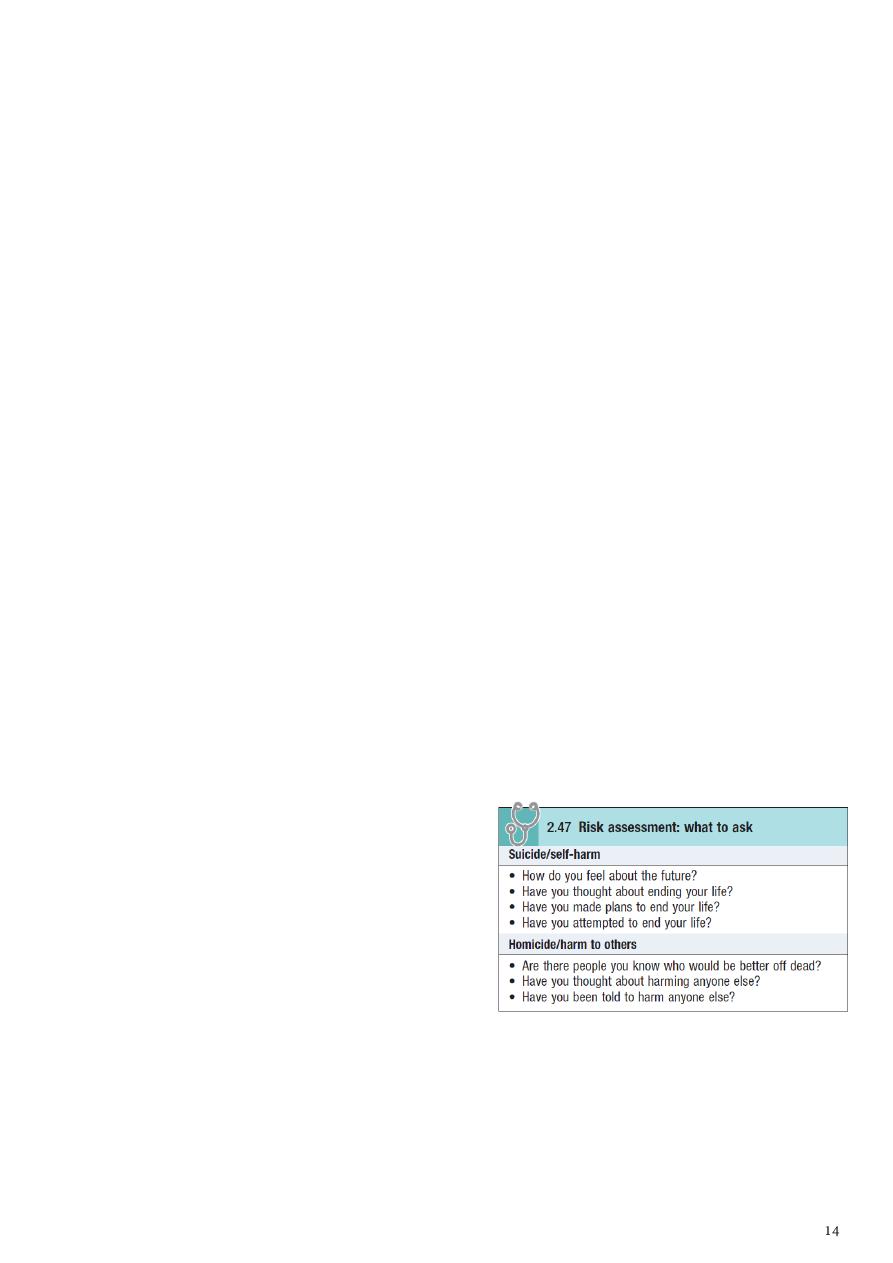
Estimate intelligence clinically from a combination of the history of educational
attainment and occupations, and at interview from vocabulary, general knowledge,
abstract thought, foresight and understanding.
Definitions:
o Clouding of consciousness A reduced level of consciousness observed as
drowsiness (coma in extreme cases).
o Confabulation Plausible but false memories that cover memory gaps.
9- Insight:
Insight is the degree to which a patient agrees that he is ill and in need of treatment.
Definition:
o Insight Recognizing that abnormal mental experiences are in fact abnormal,
Accepting that these abnormalities amount to a mental illness, Accepting the need
for treatment
Ask the patient:
o Do you think anything is wrong with you?
o What do you think is the matter with you?
o If you are ill, what do you think needs to happen to make you better?
10- Possession:
Thought insertion – belief that thoughts can be put into the patients mind
Thought withdrawal – belief that thoughts can be removed from patients mind
Thought broadcasting – belief that others can hear the patients thoughts
11- Risk assessment:
The person(s) at risk.
Nature of the risk.
Evaluate risk in all psychiatric assessments
but in depth when the:
o Presentation includes acts or threats of
self-harm or reports of command hallucinations.
o Past history includes self-harm or violent behavior.
o Social circumstances show a recent, significant loss.
o Mental disorder is strongly associated with risk, e.g. depression or a paranoid state.

12- Screening questions for mental illnesses:
When you suspect an anxiety disorder
o What physical symptoms have you been experiencing?
o How relaxed have you been feeling recently?
o Have there been any particular concerns or worries on your mind recently?
When you suspect a depressive disorder
o How has your mood been recently?
o Are you still enjoying things the way you used to?
o How do you view the future just now?
When you suspect schizophrenia
o Have you any beliefs that you think other people might find odd?
o Have you had any unusual experiences recently?
o Have you had any difficulty controlling your thinking?
o Have you heard people’s voices when there’s no one around? (Where do you think
the voices come from? What do they say?)
Psychiatric rating scales:
In routine practice, scales are most widely used to assess cognitive function when an
organic brain disorder is suspected.

Part3
: Physical examination
Examination of the patient’s physical condition is an integral part of a comprehensive
psychiatric assessment. There are five main reasons why this is so:
• Physical symptoms may be a direct result of psychiatric illness (e.g. alcohol
dependency, eating disorders, physical neglect in severe depression, schizophrenia,
etc.).
• Psychiatric drugs may have physical side-effects (e.g. extra-pyramidal side-effects
[EPSEs] and antipsychotics, hypothyroidism and lithium, withdrawal syndromes).
• Physical illnesses can cause or exacerbate mental symptoms.
• Occult physical illness may be present.
• In the case of later development of illness (or more rarely, medicolegal issues) it is
helpful to have baseline physical findings documented.
General condition:
• Note height and weight.
• Does the patient look well or unwell?
• Are they underweight or are there signs of recent weight loss?
• Note bruising or other injuries and estimate their age.
Findings:
• Parkinsonian facies Antipsychotic drug treatment, Psychomotor retardation
(depression).
• Abnormal pupil size Opiate use.
• Argyll–Robertson pupil Neurosyphilis.
• Enlarged parotids (‘hamster face’) Bulimia nervosa (secondary to vomiting).
• Hypersalivation Clozapine treatment.
• Goitre Thyroid disease.
• Multiple forearm scars Borderline personality disorder.
• Multiple tattoos Dissocial personality disorder.
• Needle tracks/phlebitis IV drug use.
• Gynaecomastia Antipsychotic drug treatment, Alcoholic liver disease.
• Russell’s sign (knuckle callus) Bulimia nervosa (secondary to inducing vomiting).
• Lanugo hair Anorexia nervosa.
• Piloerection (‘goose flesh’) Opiate withdrawal.
• Excessive thinness Anorexia nervosa.

Cardiovascular system:
• Radial pulse rate, rhythm, and character.
• Blood pressure.
• Carotid bruits?
• Heart sounds. Pedal edema.
Findings:
• Rapid/irregular pulse Anxiety disorder, Drug/alcohol withdrawal, Hyperthyroidism.
• Slow pulse Hypothyroidism.
Respiratory system:
• Respiratory rate.
• Expansion.
• Percussion note.
• Breath sounds to auscultation.
Abdominal:
• Swelling or ascites.
• Masses.
• Bowel sounds.
• Hernias.
Findings:
• Enlarged liver Alcoholic liver disease, Hepatitis.
• Multiple surgical scars (‘chequerboard’ abdomen) Somatization disorder.
• Multiple self-inflicted scars Borderline personality disorder.
Neurological system:
• Pupillary response and other cranial nerves.
• Wasting.
• Tone. Power.

• Sensation. Reflexes.
• Gait. Involuntary movements.
Findings:
• Resting tremor Increased sympathetic drive (anxiety, drug/ alcohol misuse),
Antipsychotic drug treatment.
• Involuntary movements Lithium treatment, Antipsychotic drug treatment, Tic
disorder.
• Abnormal posturing Huntingtons’s/Sydenham’s chorea, Antipsychotic-induced
dystonia.
• Festinant (shuffling) gait Catatonia.
• Broad-based gait Antipsychotic drug treatment, Cerebellar disease (alcohol, lithium
toxicity).
Clinical investigation:
Clinical investigations, including blood testing, imaging techniques, and karyotyping, play a
smaller role in psychiatry than in other medical specialties.
They are mainly carried out to exclude medical conditions which may be part of the
differential diagnosis or which may be comorbid.
• Full blood count (FBC)
• Mean cell volume (MCV)
• B12/folate
• Glucose tests
• Liver function tests (LFTs)
• Antipsychotic medication
• Urea and electrolytes (U&Es)
• Creatinine clearance
• Thyroid function tests (TFTs)
• ECG (for patients on specific or high-dose antipsychotics)
• Lumbar puncture (clear evidence to suggest a neurological disorder presenting with
psychiatric symptoms)
• EEG, CT, MRI, SPECT, PET
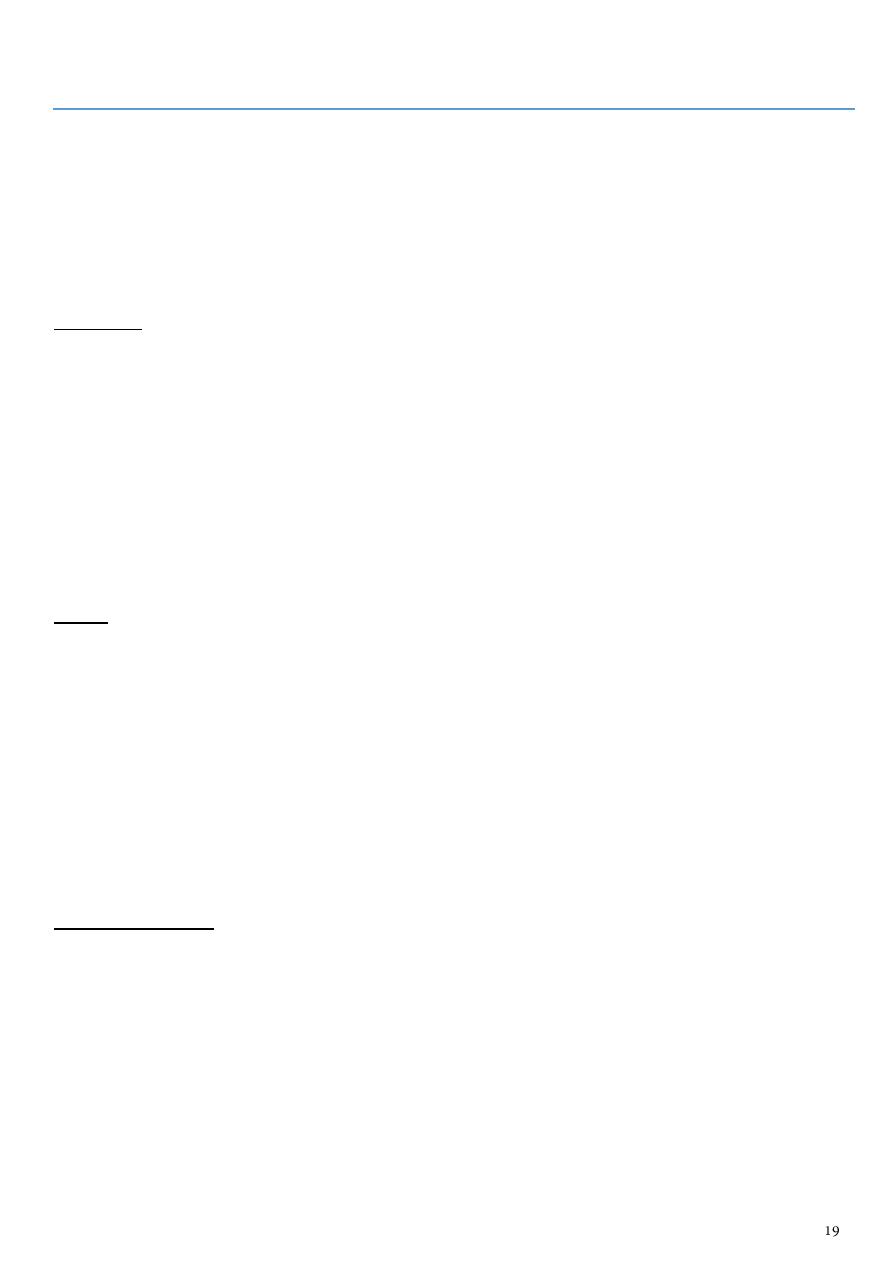
Part4
: From doctor
Abnormal beliefs:
A category of disturbance which includes delusions, over-valued ideas.
Delusions:
An abnormal belief which is held with absolute subjective certainly, which requires no
external proof, which may be held in the face of contradictory evidence, which has
personal significance and importance to individual concerned.
Excluded are those beliefs which can be understood as part of the subject's cultural or
religious background.
While the content is usually demonstrably false and bizame in nature, this is not
invariably so.
Belief:
1- Abnormal.
2- Absolute subjective certainly.
3- No external proof.
4- Contradictory evidence.
5- Personal importance and significance.
6- Exclude cultural and religious background.
7- Content usually false and bizame.
Over-valued ideas:
A form of abnormal belief. These are ideas which are reasonable and understandable in
themselves, but which come to unreasonably dominate the patient's life.
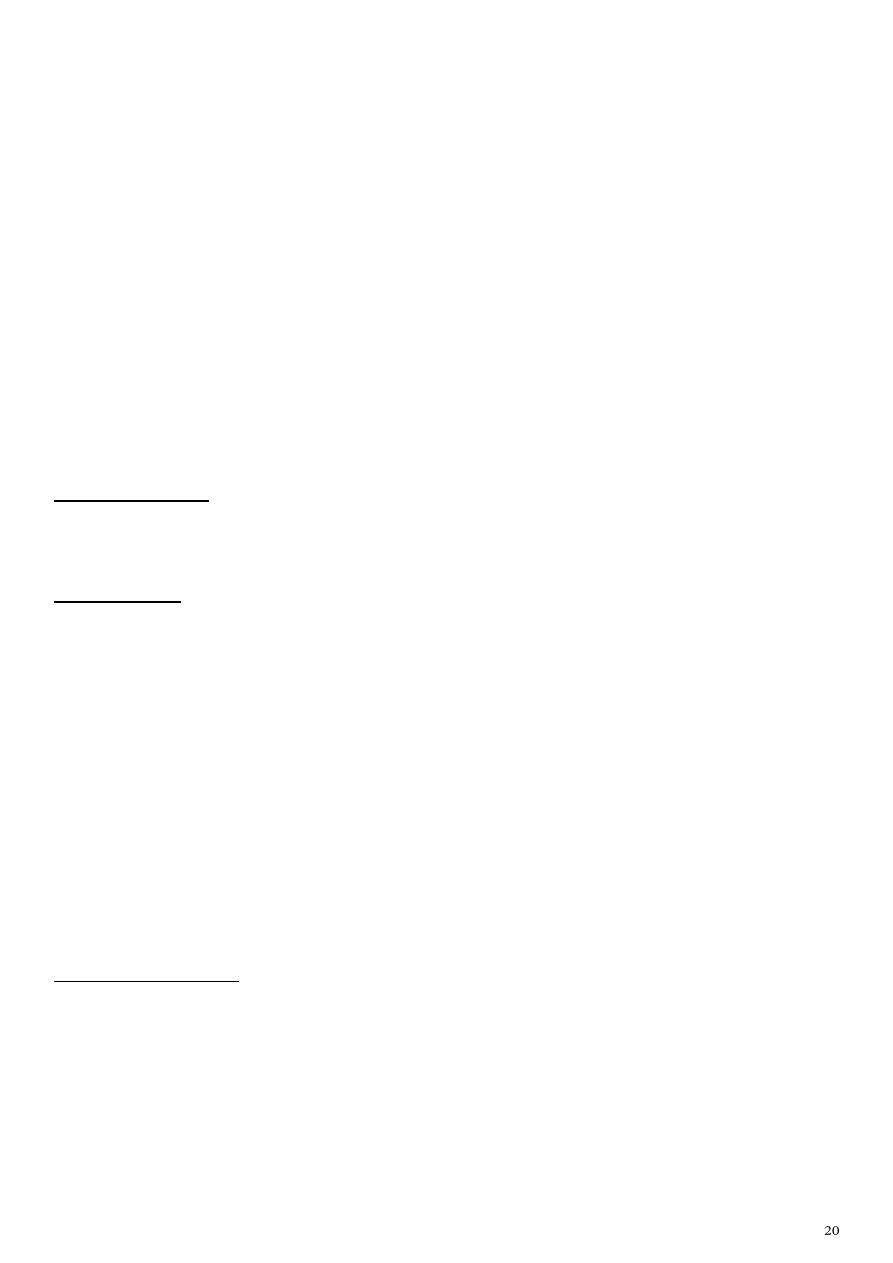
Abnormal perceptions:
A category of disturbances which includes:
- Sensory disturbance.
- False perception.
Changes in the perceived intensity as quality if a real external stimulus.
Associated with organic conditions and drug ingestion or withdrawals.
Examples include:
- Hyperacusis
hearing sound as abnormally loud.
- Micropsia
"wrong end of the telescope effect", perceiving objects which are close
as small and far away.
False perceptions: internal perceptions which do not have a corresponding object in the
external or "real" world, Includes: Hallucinations, and Pseudo-hallucinations.
Hallucinations:
An internal percept without a corresponding external object.
The subjective experience of hallucination is that of experiencing a normal percept in
that modality of sensation.
A true hallucination will be perceived as in external space, distinct from imagined
images, outside conscious control, and as possessing relative permanence.
A pseudo-hallucination will lack one or all of these characteristics.
Hallucinations are subdivided according to their modality of sensation and may be:
auditory, visual, gustatory, tactile, olfactory, or kinesthetic.
Auditory hallucination (voices) schizophrenic patient.
Visual hallucination organic illness.
Pseudo-hallucination:
A false perception which is perceived as occurring as part of one's internal experience,
not as part of the external world.
It may be described an "as if" quality or as being seen with the mind's eye.
Additionally, hallucinations experienced as true hallucination during the active phase of
a patient's illness may become perceived as pseudo-hallucinations as they receves.
They can occur in all modalities of sensation.

They are described in psychotic, organic and drug-induced conditions as well as
occasionally in normal individuals.
The Hallucinations of deceased spouses commonly described by widows and widowers
may have the form of a pseudo-hallucination.
First-rank symptoms of schizophrenia:
A group of symptoms originally described by Schneider which are useful in the diagnosis of
schizophrenia.
They are neither pathognomonic for, nor specific to, schizophrenia and are also ssen in
organic and affective psychoses.
They are 11 symptoms in 4 categories:
Auditory hallucination:
o Voices heard arguing.
o Thought echo.
o Running commentary.
Delusions of thought interference:
o Thought insertion.
o Thought withdrawal.
o Thought broadcasting.
Delusions of control:
o Passivity of affect.
o Passivity of impulse.
o Passivity of volition.
o Somatic passivity.
Delusional perception:
o A primary delusion of any content that is reported by the patient as having arisen
following the experience of a normal perception.
Voices heard arguing: A type of auditory hallucination which is first rank symptom of
schizophrenia.
The patient hears two or more voices debating with or another, sometimes about a matter
occur which the patient is agonizing (e.g. he should take the medication, its worked before ,
no not again, he will not take it this time).
Thought echo the experience of an auditory hallucination in which the content is the
individual current thoughts, also knows as gidankelautukule or echo di la pensee.

Running commentary A type of third person auditory hallucination. The patient hears
one or more voices providing a noirative of their current actions he's getting up .. now he's
going towards the window.
Thought insertion the delusional belief that thoughts are being placed in the patient's
head from outside.
Though broadcasting the delusional belief one's thoughts are accessible directly to
others.
Delusions of control:
A group of delusions which are also known as passivity phenomena or delusions of bodily
passivity.
The core feature is the delusional belief that one is no longer in sole control of one's own
body.
The individual delusions are that one is being forced by same external agent to feel
emotions (passivity of affect), to desire to do things (passivity of impulse), to perform
actions (passivity of volition), or to experience bodily sensation (somatic passivity).
Affect The emotional state prevailing in a patient at a particular moment and in
response to a particular event or situation.
Mood The subjective emotional state over a longer period of time.
Anergia the subjective feeling of lack of energy and sense of increased effort required to
carry out tasks. Associated with depressive illness.
Anhedonia the feeling of absent or significantly diminished enjoyment of previously
pleasurable activities. A core symptom of depressive illness, also a negative symptom of
schizophrenia.

Part5
: Notes
Diagnostic tests in psychiatry:
Psychological tests to assess functioning, intelligence, personality, psychopathology.
Objective: questions with right or wrong answers and projective tests questions require
interpretation of the answers and responses.
Cognitive tests: I.Q
Personality: MMPI, Rorschach test
Neuropsychological test: to detect the localized brain lesions like Halstead –Reitan
Batterytest
Biological Evaluation:
Measurement of biogenic amines, change in catecholamines.
Plasma levels of ant- psychotics and antidepressants drugs.
Dexamethasone suppression test (DST) with the normal hypothalamic –adrenal –
pitutary axis.
Endocrine functioning.
Tests:
CT, MRI, EEG, PET.
Attention:
Attention is the amount of effort exerted in focusing on certain portions of an
experience
Concentration: ability to sustain a focus on one activity
Distractibility: inability to concentrate
Selective inattention: blocking out only things that generate anxiety
Affect: observed expression of emotion, may be inconsistent with patients description
of emotion
Mood: Is a pervasive and sustained emotion, subjectively experienced and reported by
the patient and observed by others\ like depression, elation, anger

Appropriate affect: condition in which the emotional tone is in (.harmony with the
accompany idea ,thought, or speech (full affect In appropriate affect ;disharmony
between the emotional feeling - .tone and the idea ,thought ,or speech accompanying
it
Blunted affect: a disturbance in affect manifested by a sever - .reduction in the
intensity of tone
Restricted affect: reduction in intensity of feeling tone less severe than blunted affect
but clearly reduced
Flat affect: absence or near absence of any signs of affective expression ;voice
monotonous ,face immobile
Labile affect: rapid and abrupt changes in emotional feeling tone unrelated to external
stimuli
Euthymic mood: normal range of mood ,not depressed not elevated mood
Expansive mood: expression of ones feelings without - resraint,frequently with an
overestimation of ones significance or importance Irritable mood ;easily annoyed and
provoked to anger
Mood swings: rapid changes between high and low
Euphoria: intense elation with feelings of grandeur
Depression: psychopathological feelings of sadness
Anhedonia: loss of interest in and withdrawal from all - regular and pleasurable
activities often associated with depression
Disorders of thinking process:
Disturbance in the form of thought:
Loosing of association: flow of thought in which ideas shift from one subject to
another in a completely unrelated way
Derailment: gradual or sudden deviation in train of thought without blocking-
Flight of idea: rapid, continuous play in the words that produce shifting of ideas
apparently connected
Blocking: abrupt interruption in train of thinking before a thought or idea is finished
Neologism: new word created by the patient, often by combining syllables of about
other words ,for idiosyncratic psychological reasons
Word salad: incoherent mixture of word and phrases
Circumstantiality: indirect speech that is delayed in reaching the goal
Tangentiality: inability to have goal-directed associations of thought
Incoherence: non understandable, no logical connection resulting in disorganization
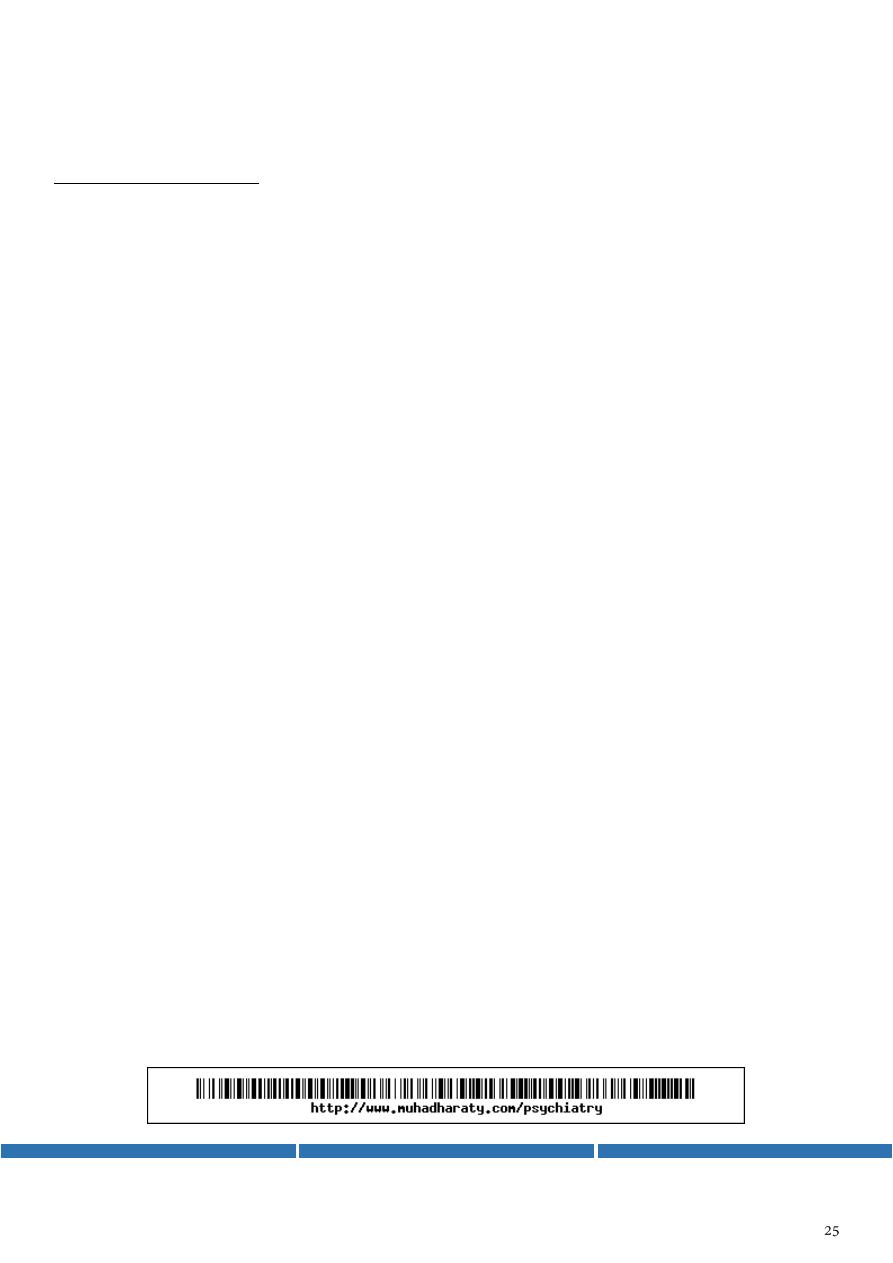
Prerseveration persisting response to a prior stimulus after a new stimulus has been
presented, often associated with cognitive disorders
Echolalia: pathologically repeating words and phrases of one person by another
Disturbance of contents
Poverty of thought: little information from thoughts due to vagueness, obscure -
phrases
Overvalued idea: unreasonable, sustained false or sometimes logical belief,
emotionally charged. Can be shared by others of same group
Delusion: fixed false belief, based on incorrect inference about external reality ,not
consistent with patient intelligent and cultural back ground, that can't be changed by
argument or reasoning
Hallucination: false sensory perception not associated with real external stimuli
(disease of perception)
